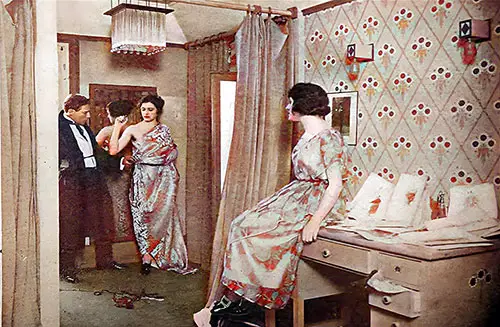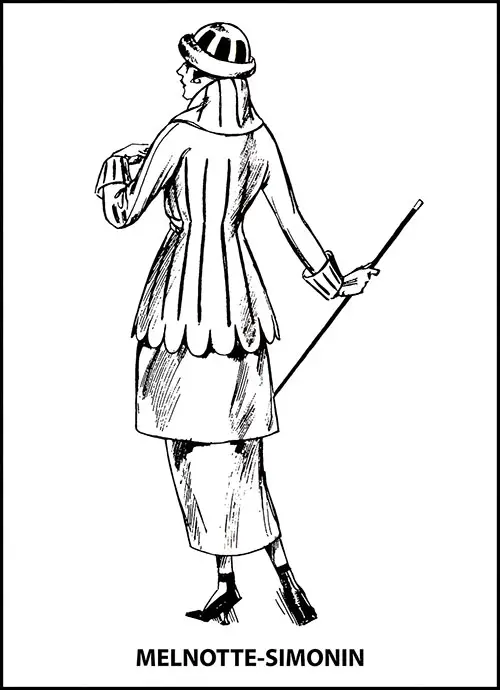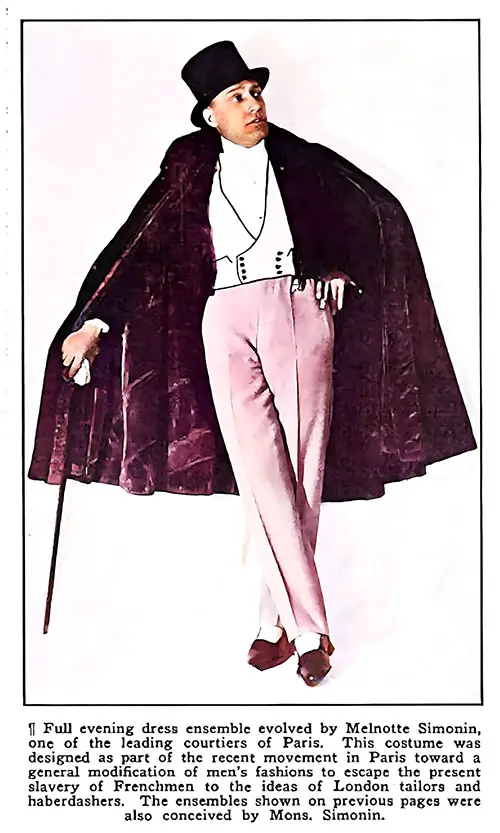Melnotte-Simonin: The Painter of Parisian Fashion Who Designed for Motion, Color, and Grace
📌 Explore the artistic fashion philosophy of Melnotte-Simonin, a Parisian couturier who blended Impressionist color, classical silhouettes, and modern tailoring. Discover how his designs shaped early 20th-century couture and ocean travel wardrobes.

Melnotte-Simonin Designed a Louis XV-Style Dark Green Velvet Tailleur Featuring Silver Edging and Embroidery. (Garment Manufacturers' Index, October 1920) | GGA Image ID # 1a3f7219d5
🎩👗 Melnotte-Simonin – The Fashion Philosopher of Rue de la Paix
At a time when post-WWI Paris was reawakening its creative spirit, the couturier Melnotte-Simonin stood out for his artistic reverence and progressive design. This captivating article paints an elegant portrait of a designer devoted not only to draping the body, but to clothing it in nature, light, and movement. 🍃💡
For fashion historians, the piece reveals a transition period from structured Edwardian silhouettes to the flowing, expressive styles of the early 1920s. For teachers and students, it provides a lens into how clothing and color were shaped by postwar sentiments, artistic movements (like Impressionism 🎨), and evolving gender roles.
For ocean travel scholars, this fashion house represents the haute couture ideals that passengers sailing aboard luxury liners—like the Cunard or White Star Line—would aspire to wear during promenades, teas, and formal dinners at sea. 🌊🛳️
Melnotte-Simonin is one of the Rue de la Paix's youngest recruits. He has created a most delightful home-like atmosphere in his salons as a fitting surrounding to his most Parisian models.
Melnotte-Simonin rejects panniers, excessive draperies, and unduly tight effects, considering them a sin against freedom of movement and natural grace of attitude. His conviction is to adapt classical lines to the modern silhouette, favoring light, loose draperies in ethereal filmy materials, velvets in severe folds, and a very Parisian collection of alert trim tailor-made.

A Corner of Melnotte-Simonin’s Artistic Studio in Paris Captures M. Simonin as He Diligently Drapes One of His Latest Creations. For This Parisian Designer, Color Plays a Crucial Role, and He Emphasizes the Generous Use of Warm and Vibrant Shades for Chic Beltless Dresses Featuring Flaring Hems. (Garment Manufacturers' Index, August 1920) | GGA Image ID # 1a3d66e5e0

Here Are the Photographs of My Most Recent Creations, Taken In My Home, Whose Artistic Atmosphere Inspired My Interpretations of Fashion—Three Typical Simonin Models That Embody Many of His Original Ideas. (Garment Manufacturers' Index, August 1920) | GGA Image ID # 1a3f660025
My first and most apparent impression is that I am far and away advanced in my ideas. The ensemble of la mode adopts many innovations I launched six months ago.
As original ideas evolve, I will transform my system of invisible tucks at the waist, suppressing the belt this winter. This novelty, introduced by me when I created my establishment, has been, by the way, taken up by almost all our great dressmakers.
This new beltless silhouette will be based on a very deeply studied system of gores, a form I have introduced on a tailor-made baptized "Louis XV," which will be photographed and sent to your following number.
The outline obtained, flaring at the hem, combines Parisian elegance with the stamp of originality.
I will trim it with fur and embroidery adapted to the new stuff designed for the Winter season.
As to the all-important question of color, I will explain all the interests I attach to it. At one of the last gatherings at Longchamp, I was struck by the warm and vivid colors of the jockey caps and jackets as they rode slowly out to the race course, compared with the monotony of the eternal blue, white, and mauve worn by the crowd in the paddock.
Mauve is mainly an impersonal shade, as the painter only obtains it by blending three or four shades.

This Suit, “Liseré Vert,” by Melnotte Simonin, Is a Navy Serge Costume Fitted at the Waist. The Seams Separate Slightly to Reveal the Green Cloth Waistcoat Underneath. (The Delineator, April 1919) | GGA Image ID # 1cb9097352
At first sight, nature and the Sun give us a symphony in different greens, expressed by the trees and grass, picked out in a few brighter spots of color made by the flowers and water.
Our greatest impressionist painters, Monet, Cézanne, and Pissarro, have helped us to realize this by painting in patches of color without attempting to render detail.
That is why I insist on the importance of the lavish hues in Nature for the elegance of outdoor meetings. To bring these impressions into the domain of clothes, I see green, black, and white (always a distinguished combination) in perfect harmony with a few tones and touches of different shades of red.
Many flowers or stripes, variations shaded in of one color on a black or dark blue ground. Our great silk manufacturers have created many fabrics with bold designs on a dark ground for the coming season, which will, I know, please you.
This will slowly return to France and Paris, the superlative grace and taste that have always made fashion a fine art. Although this elegance was abandoned during the war, it has reappeared peacefully to show the Parisienne as an ideal woman.
As the poet compares woman so aptly to a flower, let us, by all means, return to nature as a source of inspiration, light, and beauty!

Melnotte Simonin, One of the Prominent Courtiers in Paris, Developed the Complete Evening Dress Ensemble. This Costume Was Created as Part of a Recent Movement in Paris Aimed at Modifying Men’s Fashion, Allowing Them to Break Free From the Constraints Imposed by London Tailors and Haberdashers. (The Haberdasher, September 1927) | GGA Image ID # 224f106470
Bibliography
"French Couturier Favors Bright Hues," in the Garment Manufacturers' Index, New York: The Allen-Nugent Co. Publishers, Vol. II, No. 1, August 1920: 40-41.
"Melnotte-Simonin" in the Garment Manufacturers' Index, New York: The Allen-Nugent Co. Publishers, Vol. II, No. 3, October 1920: 33.
🌟 Most Engaging Elements
🖌️ 1. Design Philosophy Rooted in Art & Nature
Simonin boldly rejects panniers and tight corsetry, favoring flowing silhouettes inspired by French Impressionists like Monet and Cézanne. His approach links fashion directly to visual art and nature’s palette 🌿🎨—a compelling concept for students exploring interdisciplinary connections.
“As the poet compares woman so aptly to a flower, let us, by all means, return to nature as a source of inspiration, light, and beauty!”
🎭 2. The Home as Couture Studio
Rather than the sterile ateliers of old, Simonin welcomed clients into a “home-like atmosphere”, reflecting the modernist idea that fashion should feel personal, elegant, and comfortable. This unique presentation adds to his identity as an “artist-couturier.”
🧵 3. Beltless Dresses & Hidden Gores
Simonin claims innovation in the development of a beltless silhouette, achieved through a carefully studied system of invisible tucks and flaring gores. This architectural approach to garment construction fascinates anyone studying the evolution of tailoring.
📸 Noteworthy Images & Captions
💚 Louis XV-Style Tailleur in Dark Green Velvet | GGA Image ID # 1a3f7219d5
A striking reinterpretation of 18th-century fashion, modernized with silver embroidery and elegant folds. This ensemble would’ve dazzled at a formal shipboard event or European evening salon.
🧵 Simonin at Work in His Artistic Studio | GGA Image ID # 1a3d66e5e0
An intimate moment capturing the couturier draping fabric, emphasizing his hands-on artistry and his reverence for color as emotional language.
💙 “Liseré Vert” Suit | GGA Image ID # 1cb9097352
A navy serge costume subtly split to reveal a green cloth waistcoat—showcasing Simonin’s love of layered visual texture and Parisian tailoring.
🕴️ Evening Dress Ensemble for Men | GGA Image ID # 224f106470
An unexpected twist—Simonin also designed for men! This image connects to broader shifts in 1920s menswear, as Paris challenged London’s grip on male fashion.
📚 Mini Glossary: Terms You May Not Know
Goresh: Triangular fabric panels used to shape skirts or dresses.
Pannier: 18th-century understructures that widened skirts at the hips.
Revers: Lapels or turned-back portions of a coat/jacket.
Serge: A strong, twilled woolen fabric often used for suiting.
Tailleur: A woman’s tailored suit, often with a matching jacket and skirt.
Velours de laine: Wool velvet, soft and luxurious for cold-weather wear.
🧭 Why It Matters to Ocean Travel History
Cunard and other luxury liners maintained fashion salons and boutique services on board. Designers like Melnotte-Simonin influenced what elite passengers packed, wore, and purchased while sailing to and from Paris, New York, and London. This article provides a glimpse into what was fashionable at sea—and how couture adapted to movement and visibility, both on land and aboard.
For genealogists, these garments offer clues to a family’s social class, travel habits, and purchasing power. A grandmother’s voyage trunks might’ve carried a tailor-made ensemble just like Simonin’s!
